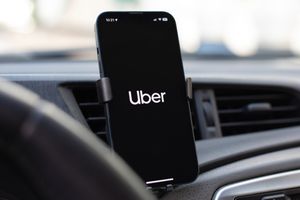
Intense competition and external factors have continued to put pressure on ride-hailing profitability.
Ruby Orimba was certain the men who accosted her in July around the General Post Office roundabout in Nairobi’s Central Business District while driving home were goons.
But she would soon learn that they were drivers registered with online ride-hailing platforms who were on strike. They mistook her car, a Nissan Note, for one of their own that had defied the boycott. After declaring a five-day strike, these irate drivers unleashed terror on the defiant ones.
"They kept checking if my car was a Bolt," said Ms Orimba in reference to one of the online applications.
They ransacked her car, looking for the slightest clue while others deflated the tyres.
The drivers were protesting what they said were exploitative fares set by the companies. Besides Bolt, an Estonian digital application, other key players in the Kenyan market include San Francisco-based Uber as well as local startups Little Ride and Faras.
The drivers think the algorithms used to set prices in the platforms have been rigged to their disadvantage while attracting more clients and earnings for the multinational companies.
“Who sets the algorithm? It is the app companies that set the algorithm. And it is usually in their favour,” says Digital Taxi Association of Kenya chairman David Muteru.
This belief that the pricing has been rigged is the reason some of the drivers have in recent weeks been arbitrarily charging customers higher fares than what is reflected on their apps when they request a ride.
Mr Duncan Minati, who has been a ride-hailing driver for the last six years, says many factors affecting the driver’s earnings are usually not considered in the final cost of a trip.
“How they calculate the fares is not even adding up. For example, you can stay for a long time waiting for a customer only for the customer to cancel the trip,” says Mr Minati.
Eight years ago, Uber drivers were all smiles as algorithms decimated the traditional taxi drivers, who protested at the entry of the new players. Now with the traditional taxi driver subdued, the boot seems to be on the other foot.
The drivers insist these algorithms—a brainless way of doing clever things— favour the technology companies.
“We believe there are experts who can set the algorithm so that everyone will go home smiling. Right now it is only the platform owners who are smiling all the way to the bank,” says Mr Muteru, whose association has for years been pushing for regulations to ensure drivers earn more money.
Mr Muteru says that during the Nairobi Economic Forum, President William Ruto promised the ride-hailing drivers that neither the app companies nor drivers would set the prices. However, the ideological gap between the app companies and the drivers on how algorithms determine pricing remains.
“For them (apps) many trips give them more commissions. Many trips for us at lower fares make our running costs higher. We consume a lot of fuel and (mobile) data. But for them, it is clean business,” says Mr Muteru.
The goal for the app companies is to capture the market by driving down the prices, says Prof XN Iraki, a business lecturer at the University of Nairobi.
“But they (Uber and other app companies) fail to factor in local circumstances like inflation,” added Prof Iraki. “The drivers also seem to have realised those who run the digital platforms take too much and are fighting back."
Cut-throat competition has been forcing the prices further down.
Uber has since raised prices by 10 per cent and Bolt is reportedly working on its price review. But such flare-ups by the drivers, which have been perennial in the last six years, are far from over.
After a frenzied ride characterised by fat returns by the e-taxi drivers, the wheels are coming off the taxi-hailing business. Part of the reason is that competition between the technology companies is stiff — and even stiffer among the drivers.
The size of the market the drivers are fighting for—the number of people willing and able to take taxis—is also not growing as fast as the drivers.
“When we started, it was good, but now things are bad. In the beginning, we (the drivers) were few so there was a lot of work,” says Mr Minati.
There are fewer customers, and most of them are grappling with a high cost of living. Many others are yet to be initiated into the taxi-hailing culture.
For example, most Nairobi residents — three in five— use matatus as their primary mode of transport and walking as the secondary one, according to a 2020 technical report by the German Agency for International Cooperation (GIZ).
Fewer Kenyans use ride-hailing taxis, with weekends being the busiest, the study found.
Uber, a Silicon Valley start-up, announced its entry in Nairobi in January 2015 in a grand way. There were great expectations for the ‘Green City in the Sun’ which “is developing at a blistering rate with endless possibilities,” said Uber on its blog.
Its launch party held at the posh DusitD2 Hotel in Nairobi was graced by everyone: From “hardcore bankers to socialites, from tech startup jocks to fashionistas.” ‘Makmende Amerudi’ hitmaker Just A Band, an alternative band, served the guests with sweet music.
Uber, which also broke its cashless policy and allowed cash and M-Pesa in Kenya, would equally attract cool drivers and riders, just like the carousers at its launch party.
At least at the beginning Uber’s business model remained within the realms of the sharing economy. Those with unused cars, which they were willing to share, were among the first drivers. Those already with a taxi-hailing culture were among the first riders in Uber taxis.
The Uber drivers were having a field day, snapping up all the customers; picking one as soon as they had dropped another. Every netizen who hadn’t been in Uber was itching for their first ride.
The traditional taxi drivers, mystified by this ‘strange technology’ that was out to finish them by mysteriously pricing way below the fares they charged, rose against Uber drivers.
But the old and jaded traditional taxi drivers who used their instincts rather than data to set prices were laughed out of town with a simple exhortation: You can’t beat technology.
Some of the traditional taxi operators tried to coalesce around taxi companies, but that didn’t work. Uber remained the new king.
Not even the entry of other app-based taxis such as Mondo Ride, Mara Moja and Easy Taxi, shook Uber.
To most customers, Uber offered value for money; their cars were cleaner and comfortable and the drivers were pleasant. It was also easy to be connected to a driver at the touch of a phone screen. Mondo Ride and Mara Moja would later disappear. Easy Taxi stalled and was later acquired by Safaricom-backed Little Cabs (now Little Ride).
Money kept streaming in for Uber drivers, and more Kenyans kept joining the party.
When the national statistician gave numbers from the transport regulator showing that the number of Public Service Vehicle licences issued in 2019 rose by 10.3 per cent to 63,938, the increase was attributed to the rise of taxi-hailing platforms.
Business was good. Mr Minati remembers giving the car owner Sh2,500 every day. “Back then, there were very few cars. These common small cars that consume less fuel were not around,” says Mr Minati.
But as more Kenyans took out loans and plunged into the ride-hailing frenzy as a full-time business, returns started to reduce into a trickle. Unlike other markets where the customer’s fare was only shared between the technology company and the driver, the chain was longer in Kenya: the app company, car owner, driver, and bank.
In 2016 Taxify and Little Cab joined the fray with lower charges, setting off a brutal price war that would painfully eat into the drivers’ margins.
A year later, Uber responded by cutting charges per kilometre to Sh35 from Sh60, noting that this was to attract more customers. It also cut the waiting time per minute to Sh3 from Sh4.
By the end of 2018, the digital apps were charging between Sh20 and 27 per kilometre triggering another wave of protests.
In 2019, the ride-hailing drivers had a nationwide strike that led to the 18 per cent commission cap enforcement in 2022. Despite cutting the charges, Uber maintained its commission at 25 per cent. Bolt’s commission was 20 per cent while Little Ride’s was 19 per cent.
Also in 2018, Uber unveiled the small, fuel-efficient Uber Chap Chap. This tiny car, Suzuki Alto 800, whose 800-cc fuel consumption is comparable to the three-wheeled tuk-tuk that helps people move within the city of Nairobi. Uber’s minimum fare was Sh190.
Less than a year later, Taxify, which would be renamed Bolt, followed suit with the launch of its own Taxify Go which allowed riders to pay a minimum of Sh100.
Most of the Uber Chap Chap cars were acquired through a lending arrangement that Uber entered with Sidian Bank and Stanbic Bank.
By September 2018, the two banks had advanced loans to more than 500 Uber drivers, said Uber.
Stanbic confirmed that 350 drivers had acquired their own vehicles over the 17 months.
Uber reasoned that the small, economy-class tiny cars were supposed to lure the masses while those who could afford to pay a premium for comfort and convenience continued riding in the relatively costly cars.
But to their dismay, all the customers flocked to the cheap taxis leaving the others without people to carry but loans to pay.
Things got worse in 2020 with the outbreak of Covid-19 pandemic. The restriction in movement, combined with lower earnings by Kenyans, made many drivers who had taken loans default—leading to many of them being auctioned.
Although competition, which has been heightened with the entry of companies like Faras, has been the main reason for the race to the bottom that drivers say is hurting them, the online taxi apps should take note of inflation or they will lose the market, says Prof Iraki.
For some of the drivers, their constant whining about being victimised by the apps will only end when they set up their own companies with prices that favour them. Experts say this is easier said than done.
“We do agree that the technology is very good. I just come to your doorstep, even if you are a stranger, and pick you up. That was very innovative,” Mr Muteru says.
But, he adds, “You cannot innovate on other people’s (driver’s) investments and resources” without commensurate compensation.
Uber and Bolt were yet to respond to our enquiries by the time of going to press.







